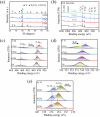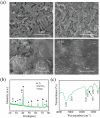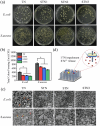Enhanced biological performance of Sr2+-doped nanorods on titanium implants by surface thermal-chemical treatment
- PMID: 40549257
- PMCID: PMC12185598
- DOI: 10.1007/s10856-025-06898-z
Enhanced biological performance of Sr2+-doped nanorods on titanium implants by surface thermal-chemical treatment
Abstract
Titanium alloys, as artificial implants for orthopedic diseases, are prone to aseptic loosening and infection after surgery because their smooth surface restricts the attachment and movement of osteoblasts, resulting in a lack of osteogenic and antimicrobial properties. This study aimed to prepare SrTiO3 nanostructures with varying Sr content on the surface of titanium through a thermal-chemical treatment, enhancing the osteogenic capacity of titanium while providing antibacterial properties. The results indicated that the SrTiO3 nanostructures are primarily composed of pure titanium and SrTiO3 phases, exhibiting a rod-like surface morphology. Sr is uniformly distributed across the surface of the samples, and increasing the Sr content does not alter the morphology of the nanostructures. Wettability tests demonstrated that the SrTiO3 nanostructures exhibited superhydrophilicity, promoting cell adhesion. Electrochemical tests revealed that the SrTiO3 nanostructures prepared on the titanium surface significantly enhanced its corrosion resistance. After 14 days of immersion in simulated body fluids, a significant amount of hydroxyapatite formed on the surface of STN3, indicating that the SrTiO3 nanostructures possess good bioactivity. In vitro antimicrobial tests demonstrated that SrTiO3 nanostructures were effective against both Escherichia coli and Staphylococcus aureus, with the antimicrobial rates increasing alongside the Sr content, reaching 48.1% and 38.6%, respectively.
© 2025. The Author(s).
Conflict of interest statement
Compliance with ethical standards. Conflict of interest: The authors declare no competing interests.
Figures






Similar articles
-
Enhanced osteogenesis and antibacterial activity of dual-functional PEEK implants via biomimetic polydopamine modification with chondroitin sulfate and levofloxacin.J Biomater Sci Polym Ed. 2024 Dec;35(18):2790-2806. doi: 10.1080/09205063.2024.2390745. Epub 2024 Aug 18. J Biomater Sci Polym Ed. 2024. PMID: 39155420
-
Bifunctional Metal Ion-Enhanced PDA-Coated Titanium for Superior Osteogenic and Antimicrobial Performance.ACS Appl Bio Mater. 2025 Jul 21;8(7):5568-5579. doi: 10.1021/acsabm.4c01869. Epub 2025 Jun 30. ACS Appl Bio Mater. 2025. PMID: 40589221
-
Enhancement of implant performance through synergistic drug delivery and bioactivity by nanotubular titanium with hydroxyapatite coating.Int J Pharm. 2025 Aug 20;681:125854. doi: 10.1016/j.ijpharm.2025.125854. Epub 2025 Jun 13. Int J Pharm. 2025. PMID: 40517972
-
Chitosan coatings on titanium-based implants - From development to characterization and behavior: A systematic review.Carbohydr Polym. 2024 Nov 15;344:122496. doi: 10.1016/j.carbpol.2024.122496. Epub 2024 Jul 24. Carbohydr Polym. 2024. PMID: 39218539
-
How surface coatings on titanium implants affect keratinized tissue: A systematic review.J Biomed Mater Res B Appl Biomater. 2022 Jul;110(7):1713-1723. doi: 10.1002/jbm.b.35025. Epub 2022 Feb 1. J Biomed Mater Res B Appl Biomater. 2022. PMID: 35103386 Free PMC article.
References
-
- Cui YW, Wang LQ, Zhang LC. Towards load-bearing biomedical titanium-based alloys: From essential requirements to future developments. Prog Mater Sci. 2024;144:101277 10.1016/j.pmatsci.2024.101277
-
- Han X, Ma J, Tian A, Wang Y, Li Y, Dong B, et al. Surface modification techniques of titanium and titanium alloys for biomedical orthopaedics applications: A review. Colloids Surf B: Biointerfaces. 2023;227:113339 10.1016/j.colsurfb.2023.113339 - PubMed
-
- Li K, Tao B, Tian H, Wu J, Huang K, Yan C, et al. Titanium implants with antiaging effect to repair senile osteoporosis fracture. Mater Des. 2023;232:112071 10.1016/j.matdes.2023.112071
MeSH terms
Substances
Grants and funding
LinkOut - more resources
Full Text Sources
Research Materials

